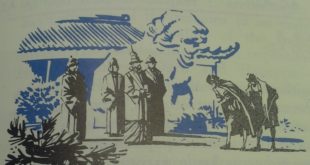In the same way that important ancient civilizations grew out of small beginnings in the valleys of the Nile, the Tigris-Euphrates and the Indus, so another great civilization of Early times — that of China — was cradled in the valley of the Yellow River. To be sure, China’s civilization did not commence as early as did Egypt’s, Mesopotamia’s, or India’s. The ancient Egyptian and the Mesopotamian kingdoms lost their power many centuries ago and early India never became completely united under one empire. China therefore has had a longer national life than any other ancient or modern state. It is the oldest of today’s nations. 1. How Did Early China Develop Under Various Ruling Families? China is dominated by three great rivers. China’s life, today as in olden times, centres in three river valleys. The great Hwang-Ho, Chinese for Yellow River, rises in the lofty mountains of Tibet. Winding its way slowly across the wide plain of North China, it flows into the Yellow Sea, so called because of the yellow soil the great river empties into it. Unlike Egypt or India, the North China plain has a climate like that of southern Canada, with warm summers and severe winters. The wind storms, disastrous dry spells and terrifying floods often bring destruction and misery to its inhabitants. Farther to the south is the valley of the Yangtze River. The Yangtze is one of the longest rivers in the world. In all, it flows nearly 4000 miles on its way to the sea. Still farther south is the Si, or West River. The climate of South China is warm and there is a heavier rainfall there than in North China. Many of China’s good ports are located along the southern coast. A Bronze Age civilization appeared first on the North …
Read More »The Coming of the Mongols A.D.1135-1368
IN 1135, Hangchow became the capital of the Southern Sung. Thereafter, the Sung kept an uneasy peace with their unwelcome northern neighbours, the Chin. Then, out of Mongolia came the mighty Genghis Khan, whose warriors and their descendants were to spread terror across Asia into Christian Europe and the lands of Islam. Before he died in 1227, Genghis had crushed the Hsi Hsia and all but crushed the Chin. His son, Ogodai, made a treaty with the Sung emperor, and the Sung and Mongol armies together put an end to the Chin. This alliance with a barbarian power turned out just as disastrously for the Chinese as Hui Tsung’s alliance with the Chin. The Mongols moved south against the Sung. When Ogodai died in 1241, his son Mangu took command. When Mangu died in 1259, a year after his cousin Hulagu destroyed the Abbasid caliphate in faraway Baghdad, his brother Kublai carried on. The Sung army resisted bravely. Both sides used cannon and catapults — huge engines which hurled rocks and bombs in the same way a crossbow hurled arrows. Some catapults were so big it took a hundred men to operate them. If the Mongols had not had such weapons, they might have been stopped. Much of South China consisted of flooded rice fields and canals and cavalry warfare would have been difficult if not impossible. In 1276, Kublai took Hangchow. Next he took Canton. In 1279 his men destroyed the last ships of the Sung fleet. Soon after this, the despairing Sung emperor flung himself from a high Cliff into the sea. Long before his victory was complete, Kublai had picked a name for his dynasty. Earlier barbarian conquerors had taken the name of a region or of a famous Chinese dynasty of the past. Kublai did not …
Read More »The Sui and T’ang Restore the Empire A.D. 589-979
IN 589, a warlord named Sui Wen Ti conquered the last dynasty in the south and so became emperor of all China. He put his subjects to work repairing the Great Wall, building palaces and digging long canals to carry water out to the fields and grain back to the cities. He sent his armies south into Vietnam and west into central Asia. In 604, he died. No one knew how he died, but many people suspected that he had been murdered by his son Yang Ti. As emperor, Yang Ti drove the people even harder than his father had. He did not care how many died of cold, hunger, or exhaustion, or in fighting his enemies. There were always plenty of other peasants who could be drafted as labourers and soldiers. At last the people grew tired of being treated like animals and rose against Yang Ti. In 618 he was assassinated and the Sui dynasty came to an end. That same year, an energetic official named Li Yuan was enthroned at the capital, Ch’ang-an, as the first emperor of the T’ang dynasty. The T’ang family was to reign until 907. Just as the brief Ch’in and Sui dynasties stood for cruelty in the minds of the Chinese, so the long-lasting Han and T’ang dynasties came to be thought of as the “golden ages” of their history. T’ANG DYNASTY’S “MYSTERIOUS ANCESTOR” The first T’ang emperors carried on the public works program of the Sui, but with less haste. Their armies triumphed everywhere. Within three quarters of a century, they had added Tibet, the Tarim Basin, Mongolia, southern Manchuria, and Korea to the empire. The greatest of the T’ang emperors was Hsüan Tsung, or “Mysterious Ancestor.” His long reign from 712 to 756, was one of the most glorious in …
Read More »


